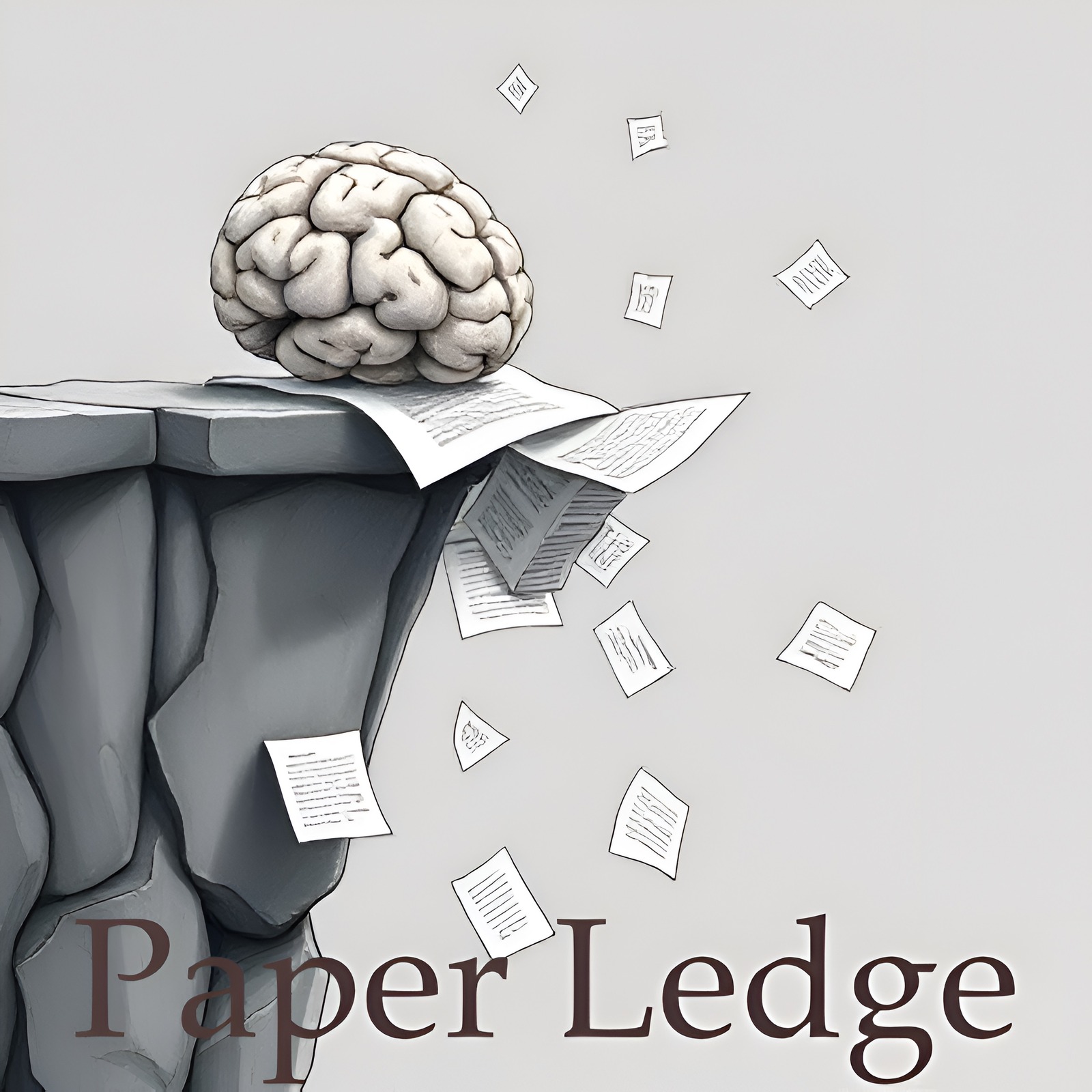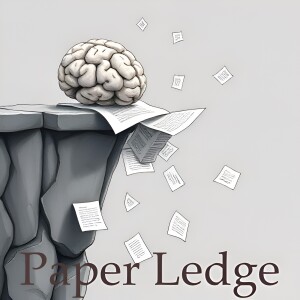PaperLedge

PaperLedge where research meets storytelling is a revolutionary podcast where cutting-edge research meets AI-powered storytelling. Hosted by the Ernis, whose blend of gentle reassurance, cosmic wonder, explanatory clarity, and enthusiastic charm makes complex research accessible to everyone. Each episode, Ernis transforms the latest academic papers into engaging, jargon-free audio experiences that deliver key insights in digestible formats. Whether you’re a researcher seeking interdisciplinary perspectives, a student supplementing your studies, or simply curious about scientific breakthroughs, PaperLedge has something for you.
Episodes
Episodes



Saturday Nov 08, 2025
Speech & Sound - PromptSep Generative Audio Separation via Multimodal Prompting
Saturday Nov 08, 2025
Saturday Nov 08, 2025
Hey PaperLedge crew, Ernis here, ready to dive into some fascinating audio wizardry! We're talking about a new tech that's making waves in how computers understand and manipulate sound. Imagine having the power to selectively pluck sounds out of a recording, or even erase them completely – all with simple instructions!
Now, usually, when we talk about separating sounds, like picking out the guitar from a rock band recording, computers rely on what's called "masking." Think of it like using stencils to isolate the guitar's frequencies. But recent research has shown that a different approach, using generative models, can actually give us cleaner results. These models are like audio artists, capable of creating (or recreating) sounds based on what they've learned.
But here's the catch: these fancy generative models for LASS, or language-queried audio source separation (I know, mouthful!), have been a bit limited. First, they mostly just separate sounds. What if you want to remove a sound entirely, like taking out that annoying squeak in your recording? Second, telling the computer which sound to focus on using only text can be tricky. It's like trying to describe a color you've never seen before!
That's where this paper comes in! Researchers have developed something called PromptSep, which aims to turn LASS into a super versatile, general-purpose sound separation tool. Think of it as the Swiss Army knife of audio editing.
So, how does PromptSep work its magic? Well, at its heart is a conditional diffusion model. Now, don't let the jargon scare you! Imagine you have a blurry image that starts as pure noise, and then, little by little, details emerge until you have a clear picture. That's kind of what a diffusion model does with sound! The "conditional" part means we can guide this process with specific instructions.
Here's the coolest part: PromptSep expands on existing LASS models using two clever tricks:
Data Simulation Elaboration: They trained the model on a ton of realistically simulated audio data. The researchers essentially created a virtual sound lab, allowing the model to learn how different sounds interact and how to separate them effectively.
Vocal Imitation Incorporation (Sketch2Sound): This is where things get really interesting. Instead of only using text descriptions, PromptSep can also use vocal imitations! You can literally hum or sing the sound you want to isolate, and the computer will understand! Think of it like playing "Name That Tune" with your computer.
The results? The researchers put PromptSep through rigorous testing, and it absolutely nailed sound removal tasks. It also excelled at separating sounds guided by vocal imitations, and it remained competitive with existing LASS methods when using text prompts.
This research basically opens the door to more intuitive and powerful audio editing tools. Imagine being able to remove background noise from a recording just by humming the noise itself!
So, why does this matter to you, the PaperLedge crew? Well:
Musicians and Sound Engineers: This could revolutionize how you mix and master tracks, giving you unprecedented control over individual sounds.
Podcasters and Content Creators: Imagine effortlessly cleaning up audio recordings, removing unwanted sounds, and making your content sound professional.
Everyday Users: Think about improving the quality of voice recordings, removing background noise from phone calls, or even creating custom sound effects for your projects.
This research is truly exciting because it makes advanced audio manipulation techniques more accessible and intuitive for everyone. It bridges the gap between human intention and computer understanding, paving the way for a future where we can interact with sound in a whole new way.
Now, here are a couple of things that have been bouncing around my head:
How far away are we from being able to use this technology to reconstruct missing audio, like filling in gaps in a damaged recording?
Could this be used for nefarious purposes, like creating deepfakes of audio conversations? What ethical considerations do we need to be thinking about?
That's it for this episode, crew! I'm really looking forward to hearing your thoughts. As always, keep learning, keep exploring, and I'll catch you on the next episode!Credit to Paper authors: Yutong Wen, Ke Chen, Prem Seetharaman, Oriol Nieto, Jiaqi Su, Rithesh Kumar, Minje Kim, Paris Smaragdis, Zeyu Jin, Justin Salamon



Saturday Nov 08, 2025
Machine Learning - Optimal Inference Schedules for Masked Diffusion Models
Saturday Nov 08, 2025
Saturday Nov 08, 2025
Alright, learning crew, gather 'round! Ernis here, ready to dive into some seriously cool research that tackles a huge problem in the world of AI language models. We're talking about making these models faster!
So, you know those super-smart language models like the ones that write articles or answer your questions? Well, the standard ones, called auto-regressive models, have a bit of a bottleneck. Imagine trying to build a Lego castle but you can only place one brick at a time, and you have to wait for the glue to dry on each brick before adding the next. That's basically how these models work: they generate text word by word, in sequence. This is super time-consuming and makes them expensive to run.
Now, some clever folks came up with a solution: diffusion language models. Think of it like this: instead of building the Lego castle brick by brick, you start with a blurry, incomplete mess of bricks, and then, little by little, you refine it until it looks like the castle you want. One of the most promising types is called the Masked Diffusion Model, or MDM. The idea is that MDMs can, in theory, fill in multiple missing words (or "tokens") at the same time, in parallel, like having a team of builders working on different parts of the castle simultaneously. This should speed things up dramatically.
"The MDM is able to sample tokens out-of-order and, ostensibly, many tokens at once and in parallel."
But here's the catch: how much parallel sampling can you actually do before the quality of the generated text starts to suffer? It's like asking how many builders you can add to your Lego team before they start bumping into each other and making mistakes. Previous research gave us some rough estimates, but they weren't very accurate.
That's where this new paper comes in! These researchers have developed a new way to precisely measure the difference between the text generated by the MDM and what it should be generating. They found a surprising connection to something called univariate function approximation, which is a fancy way of saying "figuring out the best way to represent a curve or a line." It's like finding the most efficient way to draw a smooth line using a limited number of points.
This connection allowed them to create new guidelines for how to sample words in parallel. While, ideally, there's a perfect way to decide which words to fill in at each step, the researchers found that it's generally impossible to find this perfect method without already knowing a lot about the kind of text you're trying to generate. It's like trying to guess the exact shape of the Lego castle before you even start building!
However, they also discovered that if you understand some key properties of the text – specifically, how much the words depend on each other – you can come up with smart sampling schedules that allow you to generate text much faster, in roughly O(log n) steps (where n is the length of the text), without sacrificing quality. Imagine being able to build your Lego castle in a fraction of the time by strategically placing the most important bricks first!
So, why does this research matter?
For AI developers: This provides a deeper understanding of how to optimize diffusion language models for speed and efficiency.
For businesses using AI: Faster, cheaper language models mean more cost-effective solutions for tasks like chatbots, content generation, and data analysis.
For everyone: More efficient AI can lead to breakthroughs in areas like medicine, education, and scientific research.
This research helps us understand how to make language models run faster without sacrificing quality. The key is understanding the relationships between the words in the text and using that knowledge to guide the sampling process.
Here are a couple of thought-provoking questions I'm left with:
How can we automatically determine these key properties of different types of text so we don't need to know them beforehand?
Could these findings be applied to other types of diffusion models beyond language, like those used for generating images or videos?
That's all for now, learning crew! Keep exploring, keep questioning, and I'll catch you on the next PaperLedge!Credit to Paper authors: Sitan Chen, Kevin Cong, Jerry Li



Saturday Nov 08, 2025
Saturday Nov 08, 2025
Hey PaperLedge crew, Ernis here, ready to dive into some seriously cool AI stuff! Today, we're cracking open a paper that asks: what if we could make those super-smart AI models think faster and use less brainpower? Sounds good, right?
So, you know how these big language models, like the ones that write emails or answer questions, sometimes explain why they think something? It's like showing their work in math class. This is called "Chain-of-Thought," or CoT for short. Basically, they break down the problem step-by-step, which helps them get to the right answer, especially with tricky questions.
But here's the thing: all that explaining takes a lot of effort. It's like writing a novel when you only need a paragraph. It uses up processing power and makes things slow. The paper we're looking at today tackles this head-on.
The researchers came up with a clever technique called LEASH, which stands for Logit-Entropy Adaptive Stopping Heuristic. Don't worry about the fancy name! Think of it like this: imagine you're driving a car. At first, you need to pay close attention and make lots of adjustments to the steering wheel. But once you're cruising on the highway, you can relax a bit and make fewer corrections. LEASH does something similar for AI. It figures out when the AI has "cruised" into a stable reasoning state and can stop explaining itself.
Token-level entropy slope: This basically watches how uncertain the AI is about each word it's choosing. When the uncertainty stops changing much, it's a clue the AI is getting confident.
Top-logit margin improvement: This measures how much clearer the AI's favorite answer is compared to the other options. When that difference stops growing, it means the AI is pretty sure of its answer.
When both of these signals level off, LEASH says, "Okay, you've thought enough! Time to give the answer!"
The really neat thing is that LEASH doesn't need any extra training. You can just plug it into existing AI models and it starts working. The researchers tested it on some tough math and reasoning problems, and they found that it could reduce the amount of "thinking" by 30-35% and speed things up by 27%! Now, there was a slight dip in accuracy – around 10 percentage points – but that might be a worthwhile trade-off in some situations, especially when speed and efficiency are crucial.
"LEASH is model-agnostic and requires no additional training or supervision, offering a simple and efficient alternative to CoT decoding."
Think about it: this could be a game-changer for things like:
Chatbots: Faster responses and lower server costs!
Medical diagnosis: Quickly analyzing patient data to identify potential problems.
Financial modeling: Running complex simulations without hogging all the computing resources.
So, here's what I'm wondering, crew:
Is a 10% accuracy drop a deal-breaker for most applications? Where would we not want to sacrifice accuracy for speed?
Could we combine LEASH with other AI optimization techniques to further improve performance?
How might this impact the accessibility of AI? Could faster, more efficient models open the door for smaller organizations or individuals to use powerful AI tools?
That's all for this episode, folks. Keep pondering, and I'll catch you next time on PaperLedge!Credit to Paper authors: Mohammad Atif Quamar, Mohammad Areeb



Saturday Nov 08, 2025
Saturday Nov 08, 2025
Hey PaperLedge learning crew, Ernis here, ready to dive into some mind-blowing research! Today, we're talking about InfinityStar, and trust me, it's as cool as the name suggests. Think of it as the ultimate video-making machine, but instead of cameras and actors, it's all powered by some seriously clever code.
So, what exactly is InfinityStar? Well, imagine you're telling a story, one word at a time. Each word you choose depends on the words you've already said, right? It's a chain reaction. InfinityStar does something similar, but with pictures and video. It’s a unified spacetime autoregressive framework, which basically means it’s a system that predicts the next frame of a video based on the frames it's already created, learning from both space (the image itself) and time (how the video unfolds). Think of it like a super-smart predictive text for video!
The team behind InfinityStar has built a single, all-in-one system that can handle a bunch of different tasks. Want to turn text into a picture? InfinityStar can do it. Want to turn that picture into a moving video? No problem. Need a video that reacts to your input and keeps going for a long time? InfinityStar's got you covered! It's like having a creative Swiss Army knife for video generation.
Now, why should you care? Well, let's break it down:
For the creative types: Imagine being able to bring your wildest ideas to life with just a few lines of text! InfinityStar could be your new best friend.
For the tech enthusiasts: This is a huge leap forward in AI-powered video generation. It's pushing the boundaries of what's possible.
For everyone else: Think about the future of movies, games, and even personalized content. This kind of technology could revolutionize how we create and consume media.
Here's the kicker: InfinityStar isn't just versatile, it's also fast. The researchers ran InfinityStar on a benchmark called VBench and scored 83.74, outperforming other similar models by quite a bit! It can generate a 5-second, 720p video about 10 times faster than some of the other top methods out there. That's like going from dial-up internet to fiber optic in the world of video creation!
"To our knowledge, InfinityStar is the first discrete autoregressive video generator capable of producing industrial level 720p videos."
That's huge! We're talking about video quality that's good enough for professional use, generated by an AI system faster than ever before.
So, what does this all mean for the future?
Will tools like InfinityStar democratize video creation, allowing anyone to make high-quality videos without needing expensive equipment or specialized skills?
Could this technology be used to create realistic simulations for training or entertainment?
As AI video generation becomes more advanced, how do we ensure it's used responsibly and ethically?
The team has made the code and models publicly available, which is fantastic news for researchers and developers who want to build on this groundbreaking work. It's a big step towards a future where AI can help us unlock new levels of creativity and innovation in the world of video.
That's InfinityStar for you – a glimpse into the future of video generation. What do you think, learning crew? Are you ready for AI-powered movies?Credit to Paper authors: Jinlai Liu, Jian Han, Bin Yan, Hui Wu, Fengda Zhu, Xing Wang, Yi Jiang, Bingyue Peng, Zehuan Yuan



Friday Nov 07, 2025
Friday Nov 07, 2025
Hey PaperLedge learning crew, Ernis here, ready to dive into some fascinating research that could literally help save lives! Today we're talking about landslides - those terrifying moments when hillsides give way, causing devastation.
Now, imagine you're trying to predict where a landslide might happen. You'd probably use satellite images, right? But here's the problem: the data from different satellites can be super different. Plus, what you learn about landslides in California might not apply to, say, Nepal. It's like trying to use a recipe for cookies to bake a cake – the basic ingredients might be there, but you need to adapt!
That's where this paper comes in. Researchers have been working on something called geospatial foundation models, or GeoFMs for short. Think of them as a super-smart AI brain that's been trained on tons of Earth observation data.
This specific study focuses on adapting one particular GeoFM, called Prithvi-EO-2.0, for landslide mapping. The researchers created a clever way to analyze the problem, looking at it from three different angles:
Sensor: How well does the model handle different types of satellite images?
Label: What happens when you don't have a lot of examples of past landslides to train the model with?
Domain: Can the model accurately predict landslides in new areas it's never seen before?
They put Prithvi-EO-2.0 to the test against other AI models, including some fancy ones with names like U-Net, Segformer, and even other GeoFMs. And guess what? Prithvi-EO-2.0 crushed the competition!
“The model… proved resilient to spectral variation, maintained accuracy under label scarcity, and generalized more reliably across diverse datasets and geographic settings.”
Basically, this means that this GeoFM is really good at handling messy data, works well even with limited information, and can be used in lots of different places. It's like having a universal translator for landslide prediction!
Why is this so important? Well, accurate landslide mapping is crucial for:
Disaster Preparedness: Knowing where landslides are likely to occur helps us plan evacuation routes and build safer infrastructure.
Rapid Response: After a disaster, quick and accurate maps can help rescuers find people in need and deliver aid where it's needed most.
Environmental Monitoring: Understanding landslide patterns can help us manage forests, roads, and other human activities to reduce the risk of future events.
The researchers found that this model, because of its global pretraining and self-supervision, was adaptable and could be fine-tuned. This means the AI can learn from a mountain of available data, and then focus its learning on the problem at hand.
Now, it's not all sunshine and rainbows. The researchers also point out some challenges. These GeoFMs require a lot of computing power, which can be expensive. And we still need more high-quality, readily available data to train these models effectively.
But overall, this study shows that GeoFMs are a huge step forward in making landslide prediction more accurate, reliable, and scalable. It's a game-changer for protecting communities and the environment.
So, here are a couple of things that are on my mind:
Given the computational cost, how do we ensure that these advanced technologies are accessible to communities that need them the most, especially in developing countries?
How can we encourage greater data sharing and collaboration to build even better GeoFMs for landslide research and other environmental challenges?
I hope that got you thinking! Until next time, keep learning, keep questioning, and keep exploring!Credit to Paper authors: Wenwen Li, Sizhe Wang, Hyunho Lee, Chenyan Lu, Sujit Roy, Rahul Ramachandran, Chia-Yu Hsu



Friday Nov 07, 2025
Friday Nov 07, 2025
Alright learning crew, buckle up! Today on PaperLedge, we're diving into some seriously cool tech that could change how we get around our cities. Forget just blindly following GPS; imagine a navigation system that actually understands what you need, not just where you're going.
We're talking about a new approach to vehicle routing, and the research paper introduces something called PAVe – Personalized Agentic Vehicular Routing. Now, the traditional GPS, they are pretty good at finding the fastest or shortest route. But they often only focus on one thing at a time, like time or distance. And if you want them to consider multiple things, it gets complicated. The problem is, these systems are kinda…dumb. They don't understand you.
Think about it: your GPS doesn't know you need to swing by the dry cleaner before picking up your kid, or that you want to avoid that crazy intersection on Elm Street. It doesn't understand you're running late for a meeting and need the absolute fastest route, even if it's a little less scenic. Current navigation systems don't get the context of your trip.
That's where PAVe comes in. This system is like giving your GPS a brain and a personality! The core idea is to combine the power of classic routing algorithms – like the ones that find the best way from A to B – with the smarts of a Large Language Model, or LLM. Think of an LLM as a super-powered AI that can understand and respond to complex language, just like a person.
So, how does it work? First, PAVe uses a souped-up version of a classic algorithm to generate a few different route options – let's say, one that's fastest and one that's most eco-friendly (lower CO2 emissions). Then, the LLM agent steps in. You tell it what you need – "Drop off laundry, then go to school, fastest route" – and it uses that information, along with a pre-loaded map of local Points of Interest (POIs) – like dry cleaners, schools, and your favorite coffee shop – to pick the best route for you.
It's like having a super-efficient personal assistant in your car. Instead of just spitting out directions, it reasons about your needs and preferences to tailor the route perfectly.
The researchers tested PAVe in realistic urban scenarios, and it got it right over 88% of the time! That's pretty impressive.
This research matters for a bunch of reasons:
For commuters: Imagine less stressful, more efficient commutes that take into account your real-world needs.
For businesses: Think about delivery companies optimizing routes not just for speed, but also for customer satisfaction and fuel efficiency.
For city planners: This technology could help us understand how people move around cities and design better transportation systems.
Now, this all sounds amazing, but it also raises a few questions:
How much personal data does PAVe need to be truly effective, and how do we ensure that data is protected?
Could systems like PAVe actually increase traffic congestion by optimizing routes for individual users, without considering the overall flow of traffic?
What happens when PAVe gets it wrong? How does it handle unexpected situations or conflicting priorities?
These are tough questions, but they're important to consider as we move towards a future of more intelligent and personalized transportation. It's not just about getting from A to B; it's about making the journey smarter, more efficient, and more human.Credit to Paper authors: Carnot Braun, Rafael O. Jarczewski, Gabriel U. Talasso, Leandro A. Villas, Allan M. de Souza



Friday Nov 07, 2025
Friday Nov 07, 2025
Hey PaperLedge learning crew, Ernis here, ready to dive into some fascinating research! Today we're talking about something that's both incredibly cool and potentially a bit…well, energy-intensive. We're looking at web agents – think of them as your personal AI assistants that can surf the web for you.
These aren't your grandma's search engines! We're talking about sophisticated systems, like OpenAI's Operator or Google's Project Mariner, that can autonomously roam the internet. They can navigate websites, fill out forms, compare prices – basically, do all the tedious online tasks you hate. Imagine them as little digital interns, tirelessly working on your behalf. Pretty neat, right?
But here's the thing: all that digital legwork takes energy. And this paper asks a crucial question: what's the environmental cost of these super-efficient web agents? While everyone's been focusing on how amazing these tools are, this research shines a spotlight on their potential carbon footprint.
The researchers took a two-pronged approach. First, they tried to estimate the energy consumption of these web agents theoretically. Think of it like trying to figure out how much gas a car will use based on its engine size and how far it's driven. Then, they put some web agents to the test, benchmarking them in real-world scenarios to see how much energy they actually consumed. It's like putting different cars on a track to see which one is the most fuel-efficient.
And what did they find? Well, it turns out that different approaches to building these web agents can have a HUGE impact on their energy consumption. Some are like gas-guzzling SUVs, while others are more like hybrid cars. And the kicker? The agents that consume the most energy aren't necessarily the best performers! It's like finding out that the SUV is slow and clumsy, despite burning all that fuel.
"Our results show how different philosophies in web agent creation can severely impact the associated expended energy, and that more energy consumed does not necessarily equate to better results."
Now, this is where things get a little tricky. The researchers also pointed out a lack of transparency from some companies about the inner workings of their web agents. It's like trying to figure out how much gas a car uses when the manufacturer won't tell you anything about the engine! This lack of information makes it difficult to accurately estimate their energy consumption.
So, why does this matter? Well, for starters, it matters to anyone who cares about the environment. As AI becomes more prevalent, we need to be mindful of its energy footprint. But it also matters to developers building these web agents. It highlights the need to consider energy efficiency as a key metric, just like performance and accuracy. Think about it: should we build a web agent that's slightly faster but consumes twice the energy? Maybe not!
This research is a call to action, urging us to rethink how we evaluate web agents. It's not enough to just look at how well they perform; we also need to consider their energy consumption.
This leads to some interesting questions, doesn't it?
If we start measuring energy consumption, will it incentivize developers to create more energy-efficient web agents?
What kind of regulations or standards might be needed to ensure transparency and accountability in this area?
And ultimately, how do we balance the benefits of these powerful AI tools with their environmental impact?
Food for thought, learning crew! Until next time, keep exploring!Credit to Paper authors: Lars Krupp, Daniel Geißler, Vishal Banwari, Paul Lukowicz, Jakob Karolus



Friday Nov 07, 2025
Friday Nov 07, 2025
Hey learning crew, Ernis here, ready to dive into some seriously cool tech! Today, we're talking about something that's changing how programmers work: AI coding assistants. Think of them as your super-smart pair programmer, always ready to help you debug or add features to your code.
Now, these AI assistants are getting really good at something called instructed code editing. Basically, you tell the AI what you want to change in your code, and it makes the edits for you. Sounds amazing, right? But how do we actually know how good they are? That's where things get tricky.
See, most of the tests we use right now to evaluate these AI assistants aren't quite up to the task. They often rely on code examples and instructions that are a bit… artificial. It's like testing a race car on a perfectly smooth track when it needs to handle real-world potholes and hairpin turns!
That's why some researchers decided to create a new benchmark called EDIT-Bench. Think of it as a tough new training ground for AI coding assistants, one that reflects the real-world chaos of coding.
EDIT-Bench is packed with 545 problems taken directly from real-world coding scenarios. It covers a bunch of different programming languages and use cases. We're talking about everything from fixing annoying bugs to adding completely new features. It's a diverse and realistic challenge.
But here's the really clever part: EDIT-Bench also tests how well these AI assistants can understand the context of the code. Imagine you’re asking someone to change a specific line in a document. You wouldn’t just point at the line, you’d also tell them why you want to change it and how it fits into the overall document. EDIT-Bench does the same thing for code. It makes the AI consider highlighted code, the position of the cursor, and the user's specific instructions.
"EDIT-Bench introduces context-dependent problems that require the model to understand code context, highlighted code, and cursor position in addition to the user instruction."
So, how did the AI assistants perform on this tough new test? The researchers put 40 different AI models through the wringer, and the results were… interesting. Only a handful managed to score above 60%. This shows that EDIT-Bench is a real challenge, even for the most advanced AI assistants.
The researchers also noticed that the AI's performance varied a lot depending on the type of instructions they were given. Some instructions were easier to understand and execute than others. And here's another fascinating detail: how much context the AI was given made a huge difference. In some cases, giving the AI more information about the surrounding code improved its performance by as much as 11%!
This highlights the crucial importance of testing these AI assistants in realistic scenarios. It's not enough to just see if they can make simple edits. We need to know how well they can understand the bigger picture and make changes that actually improve the code.
So, why does all this matter? Well, for programmers, it means that the AI assistants of the future will be much better at helping them write code more efficiently and with fewer errors. For companies, it means that they can develop software faster and more reliably. And for all of us, it means that we can benefit from the amazing things that software can do, from helping us manage our finances to connecting us with people all over the world.
Now, this all brings up a couple of thought-provoking questions for our discussion:
How might tools like EDIT-Bench help to standardize and improve the development process of AI coding tools?
What ethical considerations need to be addressed as AI coding assistants become more powerful and integrated into software development workflows?
I'm really excited to hear your thoughts on this, learning crew! Until next time, keep coding!Credit to Paper authors: Wayne Chi, Valerie Chen, Ryan Shar, Aditya Mittal, Jenny Liang, Wei-Lin Chiang, Anastasios Nikolas Angelopoulos, Ion Stoica, Graham Neubig, Ameet Talwalkar, Chris Donahue







